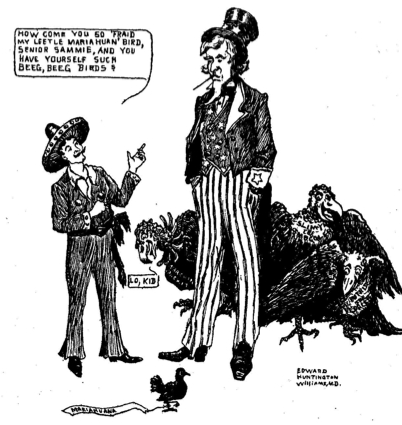Gieringer Explains AUMA (62 pages of ‘legalization’)
At the April 3 meeting of the Society of Clinicians, Dale Gieringer, the director of California NORML, described the “Adult Use of Marijuana Act” (AUMA) as a virtual certainty to make the ballot and get enacted by the voters in November 2016. Gieringer and others in a group called “ReformCA” had spent much of the past two years getting input from stakeholders and drafting an initiative that they filed last October. Reform CA reluctantly withdrew its initiative after Napster billionaire Sean Parker agreed to put up a million dollars for a 62-page initiative approved by the Drug Policy Alliance and Marijuana Policy Project. (A million dollars represents the same percentage of Parker’s net worth as $20 would for most voters. Such is “democracy” in under the Oligarchs.)
of Marijuana Act” (AUMA) as a virtual certainty to make the ballot and get enacted by the voters in November 2016. Gieringer and others in a group called “ReformCA” had spent much of the past two years getting input from stakeholders and drafting an initiative that they filed last October. Reform CA reluctantly withdrew its initiative after Napster billionaire Sean Parker agreed to put up a million dollars for a 62-page initiative approved by the Drug Policy Alliance and Marijuana Policy Project. (A million dollars represents the same percentage of Parker’s net worth as $20 would for most voters. Such is “democracy” in under the Oligarchs.)
What follows is Gieringer’s summary of AUMA as published in the California NORML Newsletter for May 2016
AUMA is an elaborate, 62-page initiative which writes hundreds of new provisions and regulations into state law. Its basic thrust is to (1) allow adults 21 years and older to possess up to one ounce of marijuana and cultivate up to six plants for personal use; (2) regulate and tax the production, manufacture, and sale of marijuana for adult use; and (3) rewrite criminal penalties so as to reduce the most common marijuana felonies to misdemeanors and allow prior offenders to petition for reduced charges. AUMA’s regulatory provisions are largely patterned on the Medical Marijuana Regulation and Safety Act (MMRSA), recently passed by the legislature and effective Jan 1, 2016. Licenses for medical and adult-use would be distinct, but managed by the same agency in the Department of Consumer Affairs (the legislature and agency may move to consolidate these two systems if AUMA passes).
Due to its extraordinary length and complexity, AUMA contains a few glitches and inconsistencies that will have to be ironed out by the courts or the legislature. Fortunately, Section 10 of the act allows for its provisions to be modified by the legislature.
SUMMARY – ADULT USE OF MARIJUANA ACT:
PERSONAL USE – SECTION 4
POSSESSION: In general, AUMA would make it lawful under both state and local law for adults 21 or over to possess, process, transport, obtain, or give away to other adults no more than one ounce (28.5 grams) of marijuana (AUMA Sec. 11362.1).
The initiative sets inconsistent limits for marijuana concentrates, allowing possession of up to 8 grams in Sec. 11362.1 (a)2 , but penalizing more than 4 grams in Sections 11357(a), (b) and (c) and 11360. This contradiction will have to be resolved by the courts or the legislature.
CULTIVATION: Adults could cultivate up to six plants and possess the marijuana from these plants at their residence for personal use (Sec. 11362.1(3)). No more than six plants per residence. (N.B: this differs from the new limit for medical users under MMRSA, which allows 100 square feet of growing space per patient, with collective gardens of up to 5 patients). All plants and harvested marijuana in excess of one ounce must be (1) kept with the person’s private residence or on its grounds, (2) in a locked apace, and (3) not visible from a public place. (11362.2). Violations of (1) –(3) are punishable as infractions with a maximum $250 fine. Cities and counties may regulate and prohibit cultivation outdoors, but cannot completely prohibit cultivation inside a private residence or accessory structure that is “fully enclosed and secure.” (11362.2(b)).
CONSUMPTION: The initiative makes it lawful to smoke or ingest marijuana, but forbids consumption in any public place except for licensed dispensaries when authorized by local governments. “Public place” is commonly construed broadly to include any business or property that is open to the public. This will greatly reduce the locations where medical patients can inhale their medicine, as they can presently consume legally in streets and public areas where smoking is permitted. Also forbidden is consumption within 1,000 feet of a school or youth center while children are present, except on residential property or on licensed premises and provided the smoking is not detectable by the kids. (11362.3(a)3).
VAPORIZERS RESTRICTED: The use of cannabis vaporizers and e-cigs is prohibited except in tobacco smoking areas (11362.3(c)), despite compelling scientific evidence that smokeless electronic vaporizers pose no public health hazard. The initiative goes on to declare that this section does not override laws regarding medical use; however, no state laws currently protect patients’ right to vaporize or consume in non-smoking areas, so this point is moot except in the handful of localities (San Francisco, Sebastopol) that have local ordinances allowing on-site medical marijuana smoking or vaporization in dispensaries.
USE IN VEHICLES: Consumption or possession of an “open container” of marijuana or marijuana products is prohibited while driving or riding as a passenger in a motor vehicle, aircraft, vessel, or other transportation vehicle. It is not clear what constitutes an “open container” of marijuana, for example, in the case of edibles or e-cigs. (Note: at present, there is no law prohibiting legal Prop 215 patients from possessing medical marijuana in open containers.) Exception: AUMA permits consumption in the passenger compartment of vehicles specially licensed for on-site consumption (11362.3(a) 4,7-8).
DRIVING WITH MARIJUANA: Sec. 11362.1 states that it is lawful for adults to transport marijuana. However, AUMA leaves standing a contrary existing law (VC 23222(b)) that makes it illegal to drive in possession of marijuana. Thus drivers could still be liable for arrest for transporting legally obtained marijuana in their car even if it was in a sealed container. A court ruling or legislative fix will be needed to resolve the evident conflict between these two provisions.
SCHOOL GROUNDS: Possession or use on school grounds is banned while children are present, as is already the case under current law. (11362.3a(5)).
MANUFACTURE WITH VOLATILE SOLVENTS – Unlicensed manufacture of concentrates using volatile or poisonous solvents (not including CO2 or ethanol alcohol) are subject to heavy felony penalties, as under current law (11362.4(a)6).
EMPLOYMENT RIGHTS: The initiative does not interfere with the right of employers to discriminate against marijuana users, medical or otherwise, both on and off the job (11362.45(f)).
PARAPHERNALIA: Marijuana accessories would be legal for adult use and manufacture. (In practice, paraphernalia offenses are rarely prosecuted in California since passage of Prop 215). 11362.1 (a) 5.
MEDICAL USE. – SECTION 5.
The initiative does not alter the protections of the Compassionate Use Act of 1996 (Prop 215) allowing medical use of marijuana (11362.45(i)). Physician recommendations must conform to minimal standards already established under MMRSA and current medical marijuana legislation (11362.712).
ID CARDS: Qualified patients must possess state ID cards if they want to be exempted from the 7.5+% sales tax currently imposed on marijuana sales (34011(g)). However, they will be subject to a new 15% excise tax and a $9.25/ounce cultivation tax. No card is required to enjoy other legal protections of Prop. 215. The cost of the state patient ID card is limited to $100, or $50 for Medi-Cal patients; free of charge for indigent patients (11362.755); this is a reduction from the prevailing fees in most counties. Identifying information in the ID cards is made subject to the Confidentiality of Medical Information Act (11362.713).
CPS/CHILD CUSTODY: Qualified patients may not be denied child custody rights merely because of their status as medical marijuana users. 11362.84.
REGULATION AND SAFETY – SECTION 6
OVERSIGHT: The Bureau of Medical Marijuana Regulation in the Department of Consumer Affairs is renamed the Bureau of Marijuana Control and given chief authority to regulate the industry. The Bureau/DCA is charged with licensing transport, distribution and sale; the Dept of Food and Agriculture with licensing cultivation; and the Dept of Public Health with licensing manufacturing and testing (Sec 26010-12).
The Bureau is to convene an advisory committee of knowledgeable stakeholders to help develop regulations and issue reports (26014).
The Governor is to appoint an independent, three-member Appeals Board to adjudicate appeals subject to standard procedures (26040).
LICENSE CATEGORIES: The initiative establishes 19 different license categories parallel to those in MMRSA, covering cultivation, manufacturing, testing, distributing, retailing, and distributing. Licenses for adult use facilities are distinct from those for medical facilities issued under MMRSA. (26050)
LARGE CULTIVATORS: A new category of Type 5 “Large” cultivation licenses is created for farms over the MMRSA limit of ½ acre indoors or 1 acre outdoors. No limit is set on the size of Type 5 gardens. No Type 5 licenses are to be issued before Jan 1, 2023. (26061(d)).
MICROBUSINESSES: A new category of Type 12 microbusiness licenses is established for small retailers with farms not exceeding 10,000 sq. ft. ( 26067 (e) 2).
VERTICAL INTEGRATION: Unlike MMRSA, AUMA does not prohibit vertical integration of licenses. In general, a licensee may hold any combination of licenses: cultivator, manufacturer, retailer, distributor and tester. The one exception is type 5 large cultivators, who may not hold distribution or testing licenses (26061(d)). In contrast, MMRSA allows applicants to have at most two different license types, effectively prohibiting direct farm-to-consumer sales (AB 266, B&P Code 19328).
DISTRIBUTORS: Unlike MMRSA, AUMA does not require that cultivators send their product to independent “distributors” (Type 11 licensees). This requirement, modeled on the alcohol industry, is one of the most controversial features of MMRSA, as it interjects a whole, new, costly distribution layer between the grower and distributor. Under AUMA, the only licensees not eligible to distribute for themselves are the new, Type 5 large-scale cultivators.
LICENSE CONDITIONS: Licenses may be denied based on various factors, including restraints on competition or monopoly power, perpetuation of the illegal market, encouraging abuse or diversion, posing a risk of exposure to minors, environmental violations, and excessive concentration in any city or county (26051).
“Excessive concentration” is defined quite loosely to include any concentration in a local census track that is higher than elsewhere in the county (26051(c)). Taken literally, this would include any new facility in a county that doesn’t already have one. An exception is made for denying applications that would “unduly limit the development of the legal market.” The overall effect is to give regulators a blank check to determine for themselves what constitutes excessive concentration. Local governments can also impose their own limits on concentration.
RESTRAINT OF TRADE: Licensees are barred from price fixing, restraint of trade, price discrimination between different locations, and selling at less than cost to undercut competitors. (26052)
NO ALCOHOL OR TOBACCO LICENSES may be held by marijuana licensees (26054(a)).
SCHOOL BUFFER ZONES: No licensee shall be located with 600 ft. of a school or youth center in existence with the license was granted, unless a state or local licensing authority allows otherwise. (26054(b)).
RESIDENCY: All licensees must be continuous California residents as of Jan 1, 2015. This restriction sunsets on Dec 31, 2019 (26054.1).
PRIORITY TO EXISTING OPERATORS: Licensing priority shall be given to applicants who can demonstrate they have acted in compliance with the Compassionate Use Act since Sept 1, 2016 (26054.2(a)).
APPLICANTS WITH PRIOR CONVICTIONS: Licenses may be denied for convictions of offenses “substantially related” to the business, including serious and violent felonies, felonies involving fraud or deceit, felonies for employment of a minor in controlled substance offenses. Except in rare cases, a prior conviction for a controlled substance offense may not in itself be the sole grounds for rejecting a license (26057(b)5). This is a departure from MMRSA, which makes past CS offenses valid grounds for license denial. CS offenses subsequent to licensing are grounds for revocation.
CULTIVATION regulations are similar to those established under MMRSA:
- Cultivators must comply with conditions set by Dept. of Fish and Wildlife and State Water Resources Control Board, plus all other state and local environmental laws (26060, 26066).
- The Dept. of Pesticide Regulation is to issue standards for use of pesticides.
- The state shall establish an organic certification program and standards for recognizing regional appellations of origin (26062-3).
- Marijuana to be regulated as an agricultural product by the Dept of Food and Agriculture (26067).
- The Dept. shall establish an identification program with unique identifiers for every marijuana plant.
TRANSPORT and DELIVERY: The Bureau shall establish standards for types of vehicles and qualifications for drivers eligible to transport commercial marijuana (26070(b)). Local government may not prevent delivery of marijuana on public roads by licensees in compliance with the initiative and local law (27080(b)). (It is unclear whether local governments retain the power to bar deliveries to medical patients in their jurisdiction, as they are authorized to do under MMRSA).
NON-PROFITS: The Bureau is to investigate the feasibility of creating nonprofit license categories with reduced fees or taxes by Jan 1, 2018 (Sec.27070.5). In the meantime, local jurisdictions may issue temporary local licenses to nonprofits primarily providing marijuana to low income persons, provided they are registered with the California AG’s Registry of Charitable Trusts. This section is of questionable effect because marijuana non-profits are not allowed on the registry due to federal law. Nonetheless, there is nothing to prevent non-profits from registering as commercial entities under the act.
MANUFACTURING and TESTING LABS are regulated by the Dept. of Public Health along similar lines as MMRSA. (26100)
LABELS: The act prescribes specific label warnings on every package of marijuana and marijuana products (26120): “GOVERNMENT WARNING: THIS PACKAGE CONTAINS MARIJUANA, A SCHEDULE I CONTROLLED SUBSTANCE. KEEP OUT OF REACH OF CHILDREN AND ANIMALS. MARIJUANA MAY ONLY BE POSSESSED OR CONSUMED BY PERSONS 21 YEARS OF AGE OR OLDER UNLESS THE PERSON IS A QUALIFIED PATIENT. MARIJUANA USE WHILE PREGNANT OR BREASTFEEDING MAY BE HARMFUL. CONSUMPTION OF MARIJUANA IMPAIRS YOUR ABILITY TO DRIVE AND OPERATE MACHINERY. PLEASE USE EXTREME CAUTION.” (The Schedule I warning is to be deleted if the federal government reschedules).
MINORS MAY BE SNITCHES: As in the alcohol industry, minors may be employed as peace officers to try to entrap marijuana dealers into illegal sales. (26140)
ADVERTISING: misleading claims and marketing to minors are banned. No billboards along interstate highways, and no use of cartoon characters, language, or music known to appeal to kids. (26150-5).
LOCAL CONTROL: Local governments may completely prohibit any type of business licensed under the act. The same is true of medical marijuana facilities under MMRSA. It is unclear whether local governments may continue to ban deliveries from licensed providers to patients in their jurisdiction (26200).
ON-SITE CONSUMPTION: Local governments may permit on-site consumption at licensed retailers and microbusinesses provided: access is prohibited to persons under 21, consumption is not visible from any “public place” or non-age-restricted area, and sale or consumption of alcohol or tobacco aren’t allowed (this effectively ends the current practice of allowing beer and wine at medical marijuana expos (26200(d)).
LABOR LAWS IN EFFECT: The Division of Labor Standards Enforcement and Occupational Safety and Health shall apply the same labor standards as apply to medical producers under MMRSA, including the requirement that all businesses with 20 or more employees have a labor peace agreement (34019(a)7).
MARIJUANA TAXES – SECTION 7
All retail sales, medical and non-medical, are subject to a 15% excise tax in addition to the regular state sales tax, effective Jan 1, 2018.
All marijuana is also subject to a cultivation tax of $9.25/ounce dry-weight for flowers or $2.75 for leaves, effective Jan 1, 2018. Other categories of harvested product are to be taxed at a similar rate based on their relative price to flowers (34012).
Patients with state ID cards would be exempt from the current 7.5+% sales tax, but not the excise or cultivation taxes. (34011)
Cities and counties may impose any taxes they please on facilities cultivating, manufacturing, processing, selling, distributing, providing, storing, or donating marijuana (as is already the case under current law) (34021).
INSPECTIONS – The board and other law enforcement officers may inspect any place where marijuana is sold, cultivated, stored to assure taxes are collected. (34016).
TAX REVENUES are allocated to a new California Marijuana Tax Fund. (34018)
Proceeds go to:
- Reasonable enforcement costs of the Bureau and other regulatory agencies not compensated by other fees (34019)
- $10 million per year from 2018 thru 2028 for California public universities to study and evaluate the implementation of the act
- $3 million per year from 2018 thru 2022 to the California Highway Patrol to establish protocols to determine whether drivers are impaired.
- $10 million per year beginning in 2018, increasing by $10 million per year to $50 million in 2022-23 to the Governor’s Office of Business and Economic Development for a community reinvestment program, at least 50% of which in grants to community nonprofits, for job placement, mental health and substance abuse treatment, legal and other services to communities disproportionately affected by the war on drugs.
- $2 million per year to the California Center for Medicinal Cannabis Research for research on efficacy and safety of medical marijuana.
Of the remaining revenues,
- 60% are allocated to a Youth Education, Prevention, Early Intervention and Treatment Account for youth programs to prevent drug abuse.
- 20% to an Environmental Restoration and Protection Account for environmental cleanup and restoration.
- 20% to a State and Local Government Law Enforcement Account for CHP DUI programs and grants to local governments relating to enforcement of the Act.
CRIMINAL OFFENSES – SECTION 8
Current marijuana laws (Health and Safety Code 11357-111360) are rewritten with a new penalty structure. In all cases, offenders under 18 are not liable to criminal punishment, but to drug education and community service.
POSSESSION (HSC 11357): Illegal possession of an ounce by persons 18- 21 continues to be a $100 infraction. Illegal possession of more than an ounce by adults continues to be a misdemeanor, punishable by $500 and/or six months in jail. Possession of less than an ounce upon a school ground during school hours by a person over 18 is a misdemeanor punishable by a fine of $250, or $500 plus 10 days in jail for repeat offenses.
CULTIVATION (HSC 11358): Illegal cultivation of six plants or less by minors 18-21 is a $100 infraction. Illegal cultivation of more than six plants is a misdemeanor punishable by $500 and/or 6 months. The current mandatory felony penalty for cultivation is eliminated, but felonies may be charged in the case of repeat offenders, persons with violent or serious priors, and various environmental offenses.
POSSESSION FOR SALE (HSC 11359): Penalties are dropped from current mandatory felonies to misdemeanors ($500 and/or 6 months). Felony enhancements allowed for repeat offenders, serious or violent priors, and sale to minors under 18.
TRANSPORTATION, IMPORTATION, SALE OR GIFT (11360): Penalties are dropped from current mandatory felony to misdemeanors ($500 and/or 6 months). Felony enhancements allowed for importing, exporting, or transporting for sale more than 1 ounce of marijuana or 4 grams of concentrate.
RELIEF FOR PRIOR OFFENDERS: Persons previously convicted of offenses that would not be a crime or would be a lesser offense under AUMA may apply to the court for a recall or dismissal of their sentence. (11361.8)
INDUSTRIAL HEMP: SECTION 9
The initiative enables legal production of industrial hemp under California’s existing hemp law, which has been in suspense pending approval by the state Attorney General and federal government.
AMENDMENT: SECTION 10
The legislature may by a 50% majority vote (1) reduce any penalties in the act, (2) add protections for employees of licensees, or (3) amend Section 5 (Medical Use) or Section 6 (Regulation and Safety) consistent with the purposes of the act. A 2/3 vote is required for other amendments.
INTERPRETATION: SECTION 11
No provision of this act shall be construed in a manner to create a positive conflict with federal law, including the Controlled Substances Act.
SEVERABILITY: SECTION 12
If any provision of this act is ruled invalid or unconstitutional, remaining provisions of the act remain in full force and effect.




